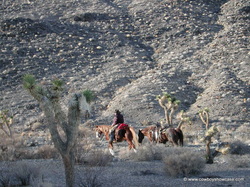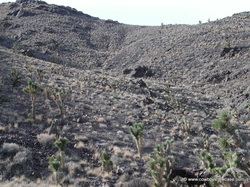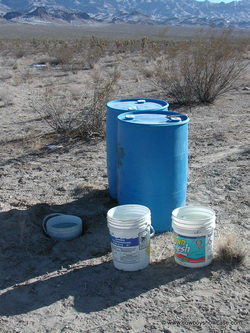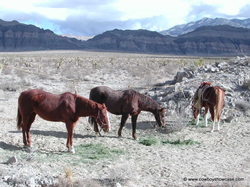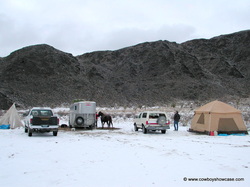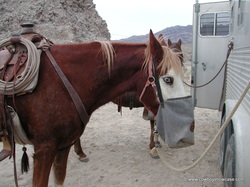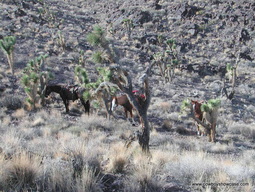Extreme Horse Camping
Tying on the Trail
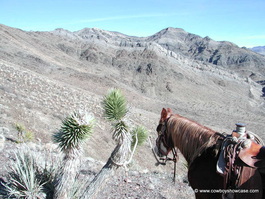
Always remember to secure your horse when you dismount on the trail.
If you stop and tie or hobble up for a while, remember to loosen the cinch a little and give your horse some air. This helps prevent saddle and girth sores that can occur when a saddle is cinched tightly for extended periods of time. However, the equipment should remain secure enough that the saddle won’t roll under the horse’s belly and create a dangerous situation.
Again, make sure you tie the rope above the horse’s shoulder and on a short lead, just where he can hold his head comfortably. The horse doesn’t need to be able to eat while tied during the ride.
Before you remount, check the blanket and pad placement and tighten the cinch.
If a horse breaks loose, he’ll probably head for the horse trailer where you unloaded or back to camp where he’s been fed. Our horses are all branded, so we have permanent, easily visible identification in case they are lost. A photo of your horse can also be helpful.
If you stop and tie or hobble up for a while, remember to loosen the cinch a little and give your horse some air. This helps prevent saddle and girth sores that can occur when a saddle is cinched tightly for extended periods of time. However, the equipment should remain secure enough that the saddle won’t roll under the horse’s belly and create a dangerous situation.
Again, make sure you tie the rope above the horse’s shoulder and on a short lead, just where he can hold his head comfortably. The horse doesn’t need to be able to eat while tied during the ride.
Before you remount, check the blanket and pad placement and tighten the cinch.
If a horse breaks loose, he’ll probably head for the horse trailer where you unloaded or back to camp where he’s been fed. Our horses are all branded, so we have permanent, easily visible identification in case they are lost. A photo of your horse can also be helpful.
Weather
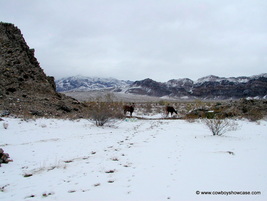
The weather can be extreme in areas such as the Desert National Wildlife Range. We experienced temperatures as low as 16 degrees Fahrenheit at night and up to 70 degrees F in the afternoon.
Dress in layers of clothing, including hat and gloves, starting with a lot of clothes in the morning and removing layers as the day progresses. Head covering is particularly important since 80% of body heat can be lost from an uncovered head. Goose down, polar fleece, and wool are good fabric choices. Bring one layer of waterproof clothing for stormy days. Our horses were haired-up, with good winter coats. If your horse is not used to being out in the elements, you could blanket them at night.
Dress in layers of clothing, including hat and gloves, starting with a lot of clothes in the morning and removing layers as the day progresses. Head covering is particularly important since 80% of body heat can be lost from an uncovered head. Goose down, polar fleece, and wool are good fabric choices. Bring one layer of waterproof clothing for stormy days. Our horses were haired-up, with good winter coats. If your horse is not used to being out in the elements, you could blanket them at night.
Pets
Desert National Wildlife Range rules require all dogs to be on leashes or chains. Train your dogs to be tied up for extended periods of time if you include them on the trip.
Coyotes were a concern in our camping area, so we kept our dogs inside the horse trailer with appropriate food and water at night and when we were hunting. The cold weather alleviated concerns about overheating and dehydration, but opening windows in the horse section of a trailer can provide ventilation on warm days.
Coyotes were a concern in our camping area, so we kept our dogs inside the horse trailer with appropriate food and water at night and when we were hunting. The cold weather alleviated concerns about overheating and dehydration, but opening windows in the horse section of a trailer can provide ventilation on warm days.
Game-Tracking
In wild country, there are no defined trails, so you must read the terrain to find the easiest way through. Terrain-reading skills come from experience and riding horses in rough country.
Look for game or cattle trails. Wild game will show you where to go if you read their sign – tracks, droppings, trails, etc. Always pay attention to landmarks to find your way back to camp.
Look for game or cattle trails. Wild game will show you where to go if you read their sign – tracks, droppings, trails, etc. Always pay attention to landmarks to find your way back to camp.
Saddlebag Essentials
- Saddlebags are essential for packing items on the trail. Here are a few things to make sure you pack before leaving camp.
Extra clothing
Food
Flashlight
First-aid kit (horse and human)
Fire-starting materials (lighter, matches, candle, etc.)
Canteen with water
Camera
Knife
Rain gear
Cell phone
Shoes, nails, and hammer Hoof pick
Desert National Wildlife Range
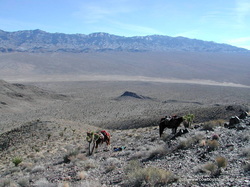
The area Lee Raine, her son, Scott, and I camped covers more than 1.5 million acres (about 2,300 square miles) in southern Nevada. All roads in the Desert National Wildlife Range are primitive, and ordinary passenger vehicles aren’t recommended. The area combines the Mojave Desert’s ecosystem with the Great Basin in a vast dry landscape.
The western portion of the Desert National Wildlife Range contains the Nellis U.S. Air Force Test and Training Range. The Nellis Range area, where we camped, is closed to the public except by special permit during a period over the Christmas and New Year holidays, when military maneuvers are usually suspended. The remainder of the Desert National Wildlife Range is open year-round.
Desert National Wildlife Refuge
4701 North Torey Pines Drive
Las Vegas, Nevada 89130
702-515-5450
http://desertcomplex.fws.gov/
Mike Laughlin [email protected]
A version of this article appeared in October 2003 Western Horseman Magazine.
The western portion of the Desert National Wildlife Range contains the Nellis U.S. Air Force Test and Training Range. The Nellis Range area, where we camped, is closed to the public except by special permit during a period over the Christmas and New Year holidays, when military maneuvers are usually suspended. The remainder of the Desert National Wildlife Range is open year-round.
Desert National Wildlife Refuge
4701 North Torey Pines Drive
Las Vegas, Nevada 89130
702-515-5450
http://desertcomplex.fws.gov/
Mike Laughlin [email protected]
A version of this article appeared in October 2003 Western Horseman Magazine.
